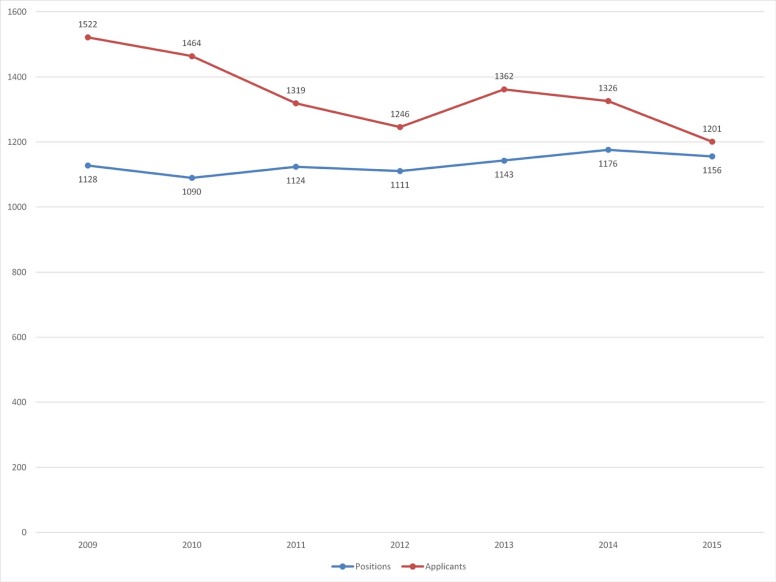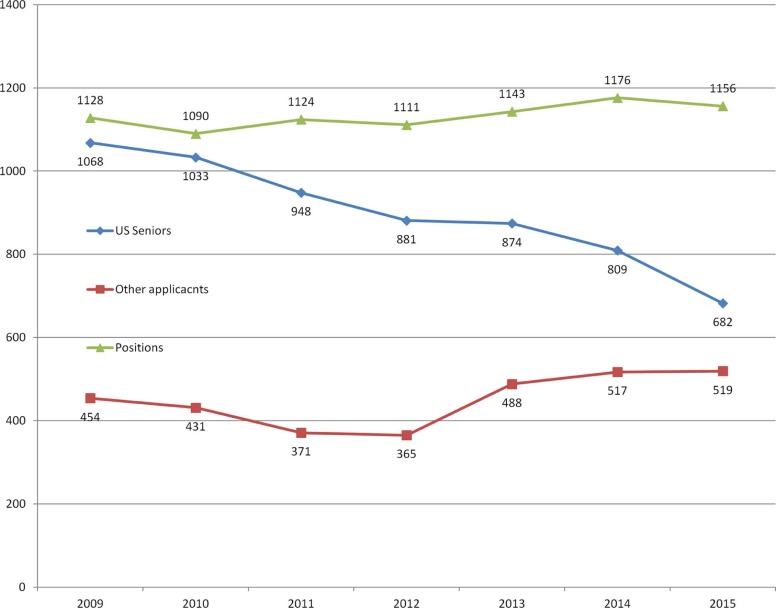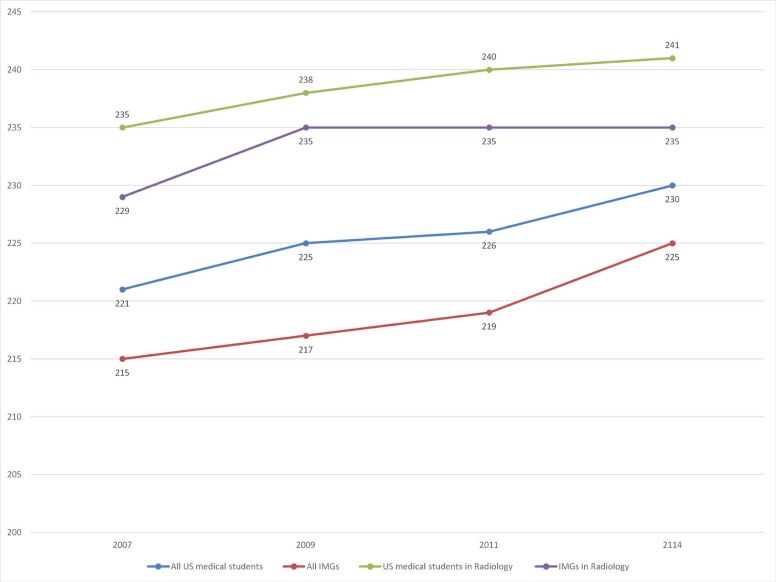Rationale and Objectives
The Association of Program Directors in Radiology regularly surveys its members regarding issues of importance to support radiology residency programs and their directors.
Materials and Methods
This is an observational cross-sectional study using two Web-based surveys posed to the Association of Program Directors in Radiology membership in the fall of 2014 (49 items) and the spring of 2015 (46 items) on the subjects of importance to the members, including the Accreditation Council on Graduate Medical Education Milestones, the Non-Interpretative Skills Curriculum, the American Board of Radiology Core Examination, the effect of the new resident testing and program accreditation paradigms on training outcomes, the 2015 Residency Match, the Interventional Radiology/Diagnostic Radiology (IR/DR) Residency, and Program Director (PD)/Program Coordinator resources.
Results
Responses were collected electronically, results were tallied using SurveyMonkey software, and qualitative responses were tabulated or summarized as comments. Findings were reported during the 63rd annual meeting of the Association of University Radiologists. The maximal response rate was 33% in the fall of 2014 and 36% in the spring of 2015.
Conclusions
PDs believed that the radiology Milestones, now largely implemented, did not affect overall resident evaluation, was not reflective of resident experience, and actually made evaluation of residents more difficult. PDs also felt that although the American Board of Radiology oral examination had been a better test for clinical practice preparedness, their new residents knew at least as much as before. There was little evidence of recall reemergence. The radiology training community saw a drop in residency applicant quality as demonstrated by the United States Medical Licensing Examination scores and clinical rotation grades. Because the new IR/DR Residency positions were to be funded at the expense of the traditional DR positions, the majority of PDs expected a negative effect of the impending IR/DR match on their DR recruitment. PDs were in favor of a unified clinical radiology curriculum similar to the Radiological Society of North America online physics modules.
Introduction
Since 2000, the Association of Program Directors in Radiology (APDR) has conducted an annual survey of its membership on issues affecting training in accredited residency programs in the United States and Canada. The APDR uses the data generated by the survey to promote improvements in resident education through exchange of ideas, to provide benchmarks guiding local resource allocation, to support the radiology residency program director (PD) community, and to facilitate communications with the Accreditation Council for Graduate Medical Education (ACGME) and the American Board of Radiology (ABR). To make information more generally accessible, the results of the APDR Annual Survey were published in 2012 and in 2015 . In this third paper, we analyze the results of the fall 2014 and spring 2015 surveys and discuss recent trends in resident education from the PD’s perspective.
For PDs and coordinators, the APDR surveys serve as real-time snapshots of prevailing educational and administrative practices, allowing benchmarking of local procedures and individual training outcomes. This work is not meant to demonstrate best practices, but rather all practices in existence at the time of the survey. The wide variation discussed in the following is the direct result of the accreditation policies. After the introduction of Milestones into residency education , the ACGME left the implementation to the professional communities, with the understanding that medical specialties were sufficiently different to make rigid uniformity counterproductive . Even within individual specialties, standardizing practices is neither always possible nor even desirable, because training programs vary in size, location, and affiliation, among other attributes. A rigid “menu prix fixe” would be too restrictive for individual educational needs. Inherent program inhomogeneity calls for an “à la carte menu” of solutions, allowing programs and entire specialties to become more innovative and where the best practices can be continuously tested. The APDR survey is meant to record and demonstrate existence of various systems in place at any given time, to facilitate exchange of ideas among the PDs.
Get Radiology Tree app to read full this article<
Materials and Methods
Get Radiology Tree app to read full this article<
Get Radiology Tree app to read full this article<
Results
Demographics
Get Radiology Tree app to read full this article<
Table 1
Respondent Demographics
Participation Fall 2014 Spring 2015 Participants 109 105 Total membership 327 295 Response rate 33% 36%Affiliation (% respondents) University 59% 70% University affiliated 20% 20% Community 19% 10% Military 2% 0%Program size (% respondents) 12 or less 10% 8% 13–28 49% 41% 29–40 25% 32% >40 16% 19%Location (% respondents) Northeast 37% 32% Southeast 19% 21% Central/Midwest 22% 28% Western 22% 19%
Get Radiology Tree app to read full this article<
Fall 2014
The Non-Interpretative Skills Curriculum
Get Radiology Tree app to read full this article<
Get Radiology Tree app to read full this article<
Program Resources
Get Radiology Tree app to read full this article<
Get Radiology Tree app to read full this article<
The ACGME Next Accreditation System (NAS) and the ABR Core Examination
Get Radiology Tree app to read full this article<
Get Radiology Tree app to read full this article<
Resident Recruitment
Get Radiology Tree app to read full this article<
Spring 2015
ACGME Milestones
Get Radiology Tree app to read full this article<
Get Radiology Tree app to read full this article<
The ABR Core Examination
Get Radiology Tree app to read full this article<
Resident Recruitment
Get Radiology Tree app to read full this article<
The Interventional Radiology/Diagnostic Radiology (IR/DR) Residency
Get Radiology Tree app to read full this article<
Dictated Reports
Get Radiology Tree app to read full this article<
Get Radiology Tree app to read full this article<
Get Radiology Tree app to read full this article<
Get Radiology Tree app to read full this article<
Get Radiology Tree app to read full this article<
Discussion
Get Radiology Tree app to read full this article<
Get Radiology Tree app to read full this article<
Get Radiology Tree app to read full this article<
Get Radiology Tree app to read full this article<
Get Radiology Tree app to read full this article<
Get Radiology Tree app to read full this article<
Get Radiology Tree app to read full this article<
Get Radiology Tree app to read full this article<
Get Radiology Tree app to read full this article<
Get Radiology Tree app to read full this article<
Get Radiology Tree app to read full this article<
Get Radiology Tree app to read full this article<
Get Radiology Tree app to read full this article<
Get Radiology Tree app to read full this article<
Conclusions
Get Radiology Tree app to read full this article<
Get Radiology Tree app to read full this article<
Acknowledgment
Get Radiology Tree app to read full this article<
References
1. Deloney L.A., Rozenshtein A., Deitte L.A., et. al.: What program directors think: results of the 2011 annual survey of the Association of Program Directors in Radiology. Acad Radiol 2012; 9: pp. 1582-1588.
2. Rozenshtein A., Mullins M.E., Deitte L.A., et. al.: “What program directors think” II: results of the 2013 and 2014 annual surveys of the Association of Program Directors in Radiology. Acad Radiol 2015; 6: pp. 787-793.
3. The Annual Survey Committee of the Association of Program Directors in Radiology. The fall 2014 survey; Available at: https://apdr.org/template.aspx?id=156&CFID=3641233&CFTOKEN=d06eb54ff0bca01e-64546977-5056-8529-979E3B24A106B8882014_Fall_Survey_Results_Final.pdf Accessed May 9, 2016
4. The Annual Survey Committee of the Association of Program Directors in Radiology. The spring 2015 survey. Available at: https://apdr.org/template.aspx?id=156&CFID=3641233&CFTOKEN=d06eb54ff0bca01e-64546977-5056-8529 -979E3B24A106B888APDR_Annual_Survey-Spring_2015.pdf Accessed May 9, 2016
5. Accreditation Council for Graduate Medical Education : Milestones. Available at: http://www.acgme.org/acgmeweb/tabid/430/ProgramandInstitutionalAccreditation/NextAccreditationSystem/Milestones.aspx Accessed May 9, 2016
6. Swing S.R.: The ACGME outcomes project: retrospective and perspective. Med Teach 2007; 29: pp. 648-654.
7. The American Board of Radiology Noniterpretative Skills Domain Specification and Resource Guide. Available at: http://theabr.org/sites/all/themes/abr-media/pdf/Noninterpretive_Skills_Domain_Specification_and_Resource_Guide.pdf Accessed May 9, 2016
8. The Radiologic Society of North America/The American Association of Physicists in Medicine Physics Taskforce. Physics modules; Available at: https://www.rsna.org/RSNA/AAPM_Online_Physics_Modules_.aspx Accessed May 9, 2016
9. The Joint Taskforce of the American College of Radiology and the Radiological Society of North America on Adult Radiation Protection. Available at: http://www.imagewisely.org/
10. Baruch Y., Brooks H.: Survey response rate levels and trends in organizational research. Hum Relat 2008; 61: pp. 1139-1160.
11. Porter R.S., Whitcomb M.E., Weitzer W.H.: Multiple surveys of students and survey fatigue. New Directions Inst Res 2004; 121: pp. 63-73.
12. The Accreditation Council for Graduate Medical Education/The American Board of Radiology Diagnostic Radiology Milestone Project. Available at: http://www.acgme.org/acgmeweb/Portals/0/PDFs/Milestones/DiagnosticRadiologyMilestones.pdf Accessed May 9, 2016
13. The National Resident Matching Program. Results and data, 2015 Main Residency Match. Available at: http://www.nrmp.org/wp-content/uploads/2015/05/Main-Match-Results-and-Data-2015_final.pdf Accessed May 9, 2016
14. Boulet J.R., Swanson D.B., Cooper R.A., et. al.: A comparison of the characteristics and examination performances of U.S. and non-U.S. citizen international medical graduates who sought Educational Commission for Foreign Medical Graduates certification: 1995–2004. Acad Med 2006; 81: pp. S116-S119.
15. Benson J.A., Meskauskas J.A., Grosso L.J.: Performance of U.S. citizen foreign medical graduates on certifying examinations in internal medicine. Am J Med 1981; 71: pp. 270-273.
16. Shea J.A., Norcini J.J., Day S.C., et. al.: Performance of U. S. citizen Caribbean medical school graduates on the American Board of Internal Medicine certifying examinations, 1984–1987. Teach Learn Med 1989; 1: pp. 10-15.
17. Norcini J.J., Anderson M.B., McKinley D.W.: The medical education of United States citizens who train abroad. Surgery 2006; 140: pp. 338-346.
18. Norcini J.J., Boulet J.R., Dauphinee W.D., et. al.: Evaluation of quality of care provided by graduates of international medical schools. Health Aff 2010; 29: pp. 1461-1468.
19. Garibaldi R.A., Subhiyah R., Moore M.E., et. al.: The in-training examination in internal medicine: an analysis of resident performance over time. Ann Intern Med 2002; 137: pp. 505-510.
20. Gozu A., Kern D.E., Wright S.M.: Similarities and differences between international medical graduates and U.S. medical graduates at six Maryland community-based internal medicine residency training programs. Acad Med 2009; 84: pp. 385-390.
21. Mamdani M., Sykora K., Li P., et. al.: Reader’s guide to critical appraisal of cohort studies: 2. Assessing potential for confounding. BMJ 2005; 330: pp. 960-962.
22. Berk A.: An introduction to sample selection bias in sociological data. Am Sociol Rev 1983; 48: pp. 386-398.
23. Tversky A., Kahneman D.: The framing of decisions and the psychology of choice. Science 1981; 211: pp. 453-458.
24. Sackett D.L.: Bias in analytical research. J Chronic Dis 1979; 32: pp. 51-63.
25. Keuter F., Presser S., Tourangeau R.: Social desirability bias in CATI, IVR, and Web surveys: the effect of mode and question sensitivity. Public Opin Q 2008; 72: pp. 847-865.


